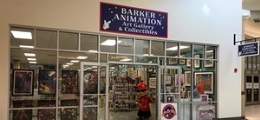Art 101
Common Art Terms
Cel
A cel, short for celluloid, is a transparent sheet of plastic material on which objects are painted. Actual celluloid (consisting of cellulose nitrate) was used during the first half of the 20th century, but since it was flammable and dimensionally unstable it was largely replaced by cellulose acetate. There are multiple types of cels available, outlined as follows:
Original Production Cel (OPC)
An original production cel is a one-of-a-kind hand painted cel that was used in production of an animated short, cartoon or feature-length film. A series of Original Production Cels would be placed over a background to be photographed in succession to form the action of a completed film.
Limited Edition Hand-Painted Cel
A non-production cel specifically created for the express purpose of the collectors’ fine art market, produced in a fixed quantity (usually 1,000 pieces and under). In addition to recreating scenes from Original Production Cels, many limited edition hand-painted cels offer collectors opportunities in which to acquire their favorite character in ideal, memorable or special interest poses. These pieces are typically hand-numbered with the studio’s seal imbedded into the artwork and laid upon a reproduction background.
Limited Edition Sericels
Similar to the limited edition hand-painted cel, a limited edition sericel is a non-production cel specifically created for the express purpose of the collectors’ fine art market, produced in a fixed quantity (usually 1,000 pieces or more). Instead of being hand-painted, images are recreated using individual silk screens per color in a process called serigraphy.
Original Production Drawing (OPD)
An original production drawing is a one-of-a-kind hand-drawn image created by animators to establish pose and action. These finalized drawings were then transferred to a cel to create the previously mentioned original production cel. An original production drawing is technically the first piece of art created to be used to produce an animated short, cartoon or feature-length film.
Giclee
Giclee refers to the process of making fine art reproductions from a digital source using a highly-stylized printer (similar to an ink-jet). The word “giclee” is derived from the French word “gicler” meaning “to squirt, spurt or spray”. Giclee printing is the highest quality fine art reproduction currently available and can be used on almost any medium (canvas, paper, etc.).
Serigraph
Serigraph refers to the process of making fine art reproductions by having a design imposed on a screen of silk (per color needed), with ink then being forced through each individual screen onto the printing surface. The serigrapher applies each color separately, one screen at a time, in perfect registration. Serigraphs are typically produced on paper, canvas, panels and cels (see sericels).
3-D Serigraph
3-D serigraph refers to the process of taking 2 or 3 fine art serigraphs and layering them in such a fashion as if parts of the image appear 3-D.
Lithograph
Lithograph refers to the process of making fine art reproductions using a stone or metal plate to transfer text or images onto paper or canvas. Individual stones/plates are needed for each color needed to complete the piece, which are then applied one stone at a time until the image is finalized.
Common Edition Types
Regular Edition (#)
Sometimes referred to as the numbered edition, this edition type is specifically created in a fixed quantity for the purpose of retail sale.
Artist Proof Edition (AP)
Once the original series of test pieces an artist would approve quality on prior to the Regular Edition being created. Now, an Artist Proof represents a special edition representing only 10 - 15% of the Regular Edition size. (For example, a Regular Edition of 200 would have between 20 and 30 Artist Proofs.) Depending on the studio and artist, Artist Proofs are either sold at a premium, or given to the artist (as part of their publication contract).
Printers Proof Edition (PP)
Once the original series of test pieces a printer would approve quality on prior to the Regular Edition being created. Now, a Printers Proof represents a special edition representing only 10 - 15% of the Regular Edition size. (For example, a Regular Edition of 200 would have between 20 and 30 Printers Proofs.) Depending on the studio and artist, Printers Proofs are either sold at a premium, or given to the printer (as part of the publication contract).
Hors de Commerce Edition (HC)
Similar to Artist Proofs, the term "Hors de Commerce" means "Out of Trade" in English. This edition is most often utilized for studio purposes – whether placed in the studio archive, utilized for gifting purposes, or in some instances, given to the artist (as part of their publication contract).
Executive Proof Edition (EP)
Rarely, if ever, available for purchase, this edition is utilized as its name would suggest – produced specifically for studio executives.
Collaborator’s Proof Edition (CP)
Specific to the Secret Art of Dr. Seuss, Similar to an Artist’s Proof (AP), the Collaborator’s Proof was created in collaboration with the printer, publisher and the Dr. Seuss Estate. This portion of the edition is reserved for special gallery exhibitions and top-selling galleries, and is made available only after the Regular Edition has sold out. This Edition is also reserved for the following:
Chase Archives
Dr. Seuss Properties™
Dr. Seuss Enterprises, L.P.
Audrey Geisel
Others As Designated By Chase Art Group






